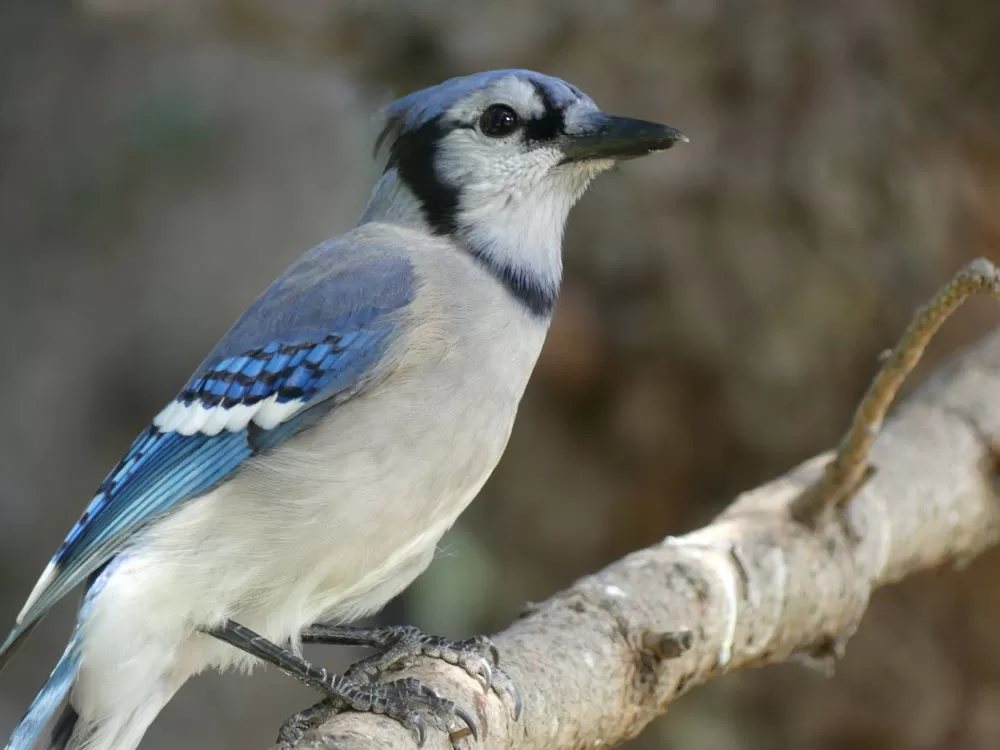Blue Jay Identification
Identifying a Blue Jay involves observing its physical characteristics and distinctive coloring. These aspects make the bird stand out in its natural habitat.
Physical Description
The Blue Jay, scientifically known as Cyanocitta cristata, exhibits several distinctive features. It has a medium build, generally measuring about 9 to 12 inches in length. The bird’s perky crest is prominent, adding to its striking appearance.
Its plumage is predominantly blue with touches of black and white. A notable feature is the black necklace or throat patch that contrasts sharply with the bright color of its feathers. The wings are also marked with black and white patterns, making them visually intriguing during flight.
Distinctive Coloring
Blue Jays are best recognized for their vibrant blue plumage, which varies in intensity depending on the light. The primary blue color extends across their back and wings, while their underside is predominantly white.
The combination of colors includes black accents on the wings and tail, enhancing their visual appeal. Males and females exhibit similar plumage, presenting minimal dimorphism in coloration. The blue is often vivid, making the Blue Jay easily identifiable among other bird species.
Habitat and Distribution
The Blue Jay thrives in various environments across North America. Its adaptability allows it to inhabit both natural and human-altered landscapes, making it a common sight in forests, residential areas, and open spaces.
Natural Habitats
Blue Jays prefer deciduous and mixed forests, especially those containing oak trees. These trees provide not only food in the form of acorns but also crucial nesting sites. The birds are often found in forest edges where they can easily forage and escape predators. Additionally, they inhabit open areas that offer a mix of tree cover and open ground, allowing for foraging and social interactions.
Range and Migration
The range of the Blue Jay extends throughout North America, from southern Canada to northern Florida. They are primarily non-migratory, but some individuals may disperse in search of food during winter months. Notably, the Florida Scrub-Jay is a unique resident of the state, preferring scrub habitats. While the Blue Jay generally remains within its established territory, fluctuating food sources may drive them into nearby residential areas, where they readily adapt to human presence.
Behavior and Diet
The Blue Jay exhibits interesting feeding habits and social dynamics that highlight its adaptability. This bird plays an important role in its ecosystem, with diet choices reflecting its opportunistic nature.
Feeding Habits
Blue Jays are omnivorous and have a varied diet consisting primarily of nuts, seeds, and insects. Their favorites include acorns, sunflower seeds, peanuts, and suet. They are known to be feeder visitors, often raiding backyard bird feeders for food.
During warmer months, they actively forage for insects, which supplement their diet with protein. Their feeding technique involves using their strong beaks to crack open hard shells of nuts. Blue Jays also store food by burying it, which helps them survive through winter months when food is scarce.
Social Interactions
The Blue Jay is a highly social bird, often found in flocks, particularly outside the breeding season. They are vocal creatures, using a variety of calls to communicate. Their calls range from sharp alarm signals to more melodious sounds during courtship.
Aggression is also a notable part of their social behavior. They can be territorial, especially during breeding, and are known to drive away intruders from their feeding areas. Family bonds are strong, as male and female partners typically remain together throughout the breeding season to care for their young.
Reproduction and Nesting
Blue Jays build nests using twigs, grass, mud, and rootlets, typically in trees or shrubs. They create an open cup nest that can be quite sturdy. The female usually lays between 3 to 7 eggs, which are incubated for about 16 to 18 days.
Both parents are involved in raising nestlings, feeding them regurgitated food. This care continues until the young fledge, usually taking 17 to 21 days after hatching. During this period, the parents remain vigilant against predators, working closely as a team to protect their offspring.
Share this content:

Post Comment
You must be logged in to post a comment.